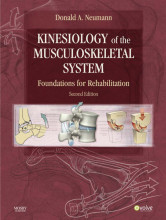Basic Structure and function of human joints
39 important questions on Basic Structure and function of human joints
What are the two major types of joints?
- Synarthroses
- Diarthroses
Where can you divide Synarthroses in?
- Firbrous
- cartilaginous
What is a Fibrous joint?
- Higher grades + faster learning
- Never study anything twice
- 100% sure, 100% understanding
What is a cartilaginous joint?
What seven element has a synovial joint?
- Synovial fluid
- Articular cartilage
- Joint capsule
- Synovial membrane
- Ligaments
- Blood vessels
- Sensory nerves
What forms the joint capsule?
What are the two layers of the joint capsule and where do they compose of and what is there function?
- The external or fibrous layer is composed of dense connective tissue. This part provides support between the bones and containment of the joints contents.
- The internal layer consists out of a synovial membrane, which averages 3 to 10 cell layers thick. These cells manufacture synovial fluid, which coats the articular surfaces of the joint. The fluid reduces friction between the joint surfaces as well as providing some nourishment to the articular cartilage.
What is the function of ligaments?
What are capsular ligaments?
What are extracapsular ligaments and what is there function?
What are Intra-articular discs or/and menisci?
What is the function of the Intra-articular discs and menisci?
WHat is the function of the peripheral labrum?
What is a fat pad and what is there function?
- Fat pads are positioned within the substance of the joint capsule, often interposed between fibrous layer and the synovial membrane.
- They thicken the joint capsule to fill nonarticulating joint spaces formed by incongruent bony contours. Fat pads reduce the volume of synovial fluid necessary for proper joint function.
What is a bursae?
What is the function of a bursea?
What is a Synovial plicae?
What is the function of a synovial plicea?
Which seven types of joint are there and name one example?
- Hinge joint, Humero-ulnar joint
- Pivot joint, Humeroradial joint
- Ellipsoid joint, Radiocarpel joint
- Ball-and-socket joint, Glenohumeral joint
- Plane joint, Carpometacarpel joint
- Saddle joint, Sternoclavicular joint
- Condyloid joint, Tibiofemoral joint
What are the primary motions of a pivot joint?
What is the primary motion of the saddle joint?
What is the primary motion of the condyloid joint?
What are the two basic shapes of joint surfaces found in the body?
- Ovoid joint
- Saddle joint
What is a Ovoid joint?
What is a saddle joint?
What are the fundamental materials to make connective tissue?
- Collagen type 1 and 2
- Elastin
- GLycosaminoglycans
- Water
- Solutes
- Fibroblasts
- Chondrocytes
What are elastin fibers?
Which three types of connective tissue is there?
- Dense connective tissue
- Articular cartilage
- Fibrocartilage
What is dense tissue?
Primary function dense connective tissue?
- Resist tension
- Ligaments and joint capsules protect and bind the joint
- Tendons transfer forces between muscle and bone
Primary function articular cartilage?
- Distributes and absorbs joint forces(compression and shear)
- Reduces joint friction
Primary function fibrocartilage?
- Supports and mechanically stabilizes the joint
- Dissipates loads across multiple planes
- Guides complex arthrokinematics
What is articular cartilage?
HOw thick is articular cartilage?
Where does bone consist of?
What is wolff's law?
What is an acute trauma?
What is a chronic trauma?
What is RA (Rheumatic Arthritis)?
The question on the page originate from the summary of the following study material:
- A unique study and practice tool
- Never study anything twice again
- Get the grades you hope for
- 100% sure, 100% understanding
































